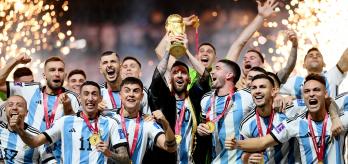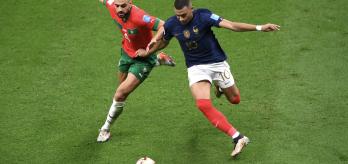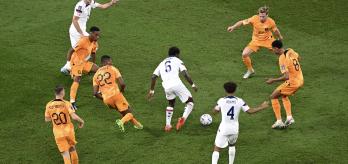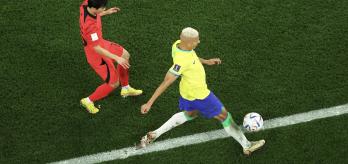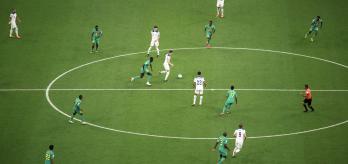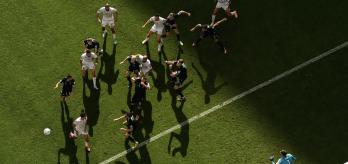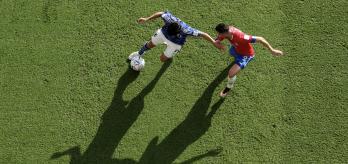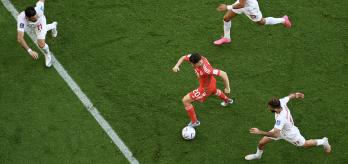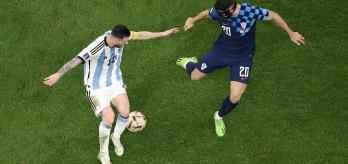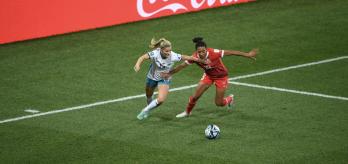Key points
-
Although most teams covered less total distance in the second half compared to the first half, this varied for the distances covered at higher intensities.
-
Most positions illustrated second-half declines for the distance covered in total and the distance covered at higher intensities. Attacking midfielders demonstrated the more pronounced second-half reductions for high-intensity and sprint metrics.
-
Teams covered similar total distances between World Cups but the distances at higher intensities were 16-19% greater during Qatar 2022 than at Russia 2018.
FIRST- VERSUS SECOND-HALF PERFORMANCES
Optimising the comparison
To allow more appropriate comparisons to be drawn between halves, the physical data from the FIFA World Cup Qatar 2022 was adjusted to account for this and was represented as metres covered per minute of match play (i.e. m/min). The adjusted data highlighted that most teams covered less total distance on a per-minute basis in the second half than in the first half. Figure 1 shows that Ecuador, Mexico, Qatar, Cameroon and Canada are close to the centre line, indicating that their first- and second-half total distances were similar.
Most teams illustrated some second-half reduction in terms of total distance, but Wales, France and Costa Rica demonstrated much more pronounced declines. Some have attributed this second-half decline to fatigue, as studies have reported depleted muscle glycogen stores at the end of a match4. However, football is a complex sport and second-half performances are impacted by much more than just fatigue because the changing game state can decrease or even increase a team's physical output (e.g. scoreline and match importance)5.
Notable team examples
To illustrate this point, Figures 2 and 3 show that some teams covered more distance on a per-minute basis at higher intensities (>20km/h and >25km/h) in the second half than in the first half. Wales and Portugal were fine examples of teams that covered more distance at the higher intensities (>20km/h and >25km/h) in the second half than in the first, while Senegal and Korea Republic's intensity tended to drop off more in the second half. The maintenance of running at higher speeds probably occurred at the expense of a more pronounced decline in total distance throughout the second half. This trend could demonstrate a pacing strategy that spares low-intensity activity such as walking and jogging in an attempt to preserve essential running at higher speeds5.
Interestingly, when the World Cup teams were classified as "high" or "low" based on the distance covered >20km/h (>90 m/min v. <90 m/min) and >25km/h in the first half (>23 m/min v. <23 m/min), the teams in the "low" group were more likely to perform more intensely in the second half (Figures 2 and 3). An unexpected finding was that the USA, Canada and Saudi Arabia covered the most distance at high intensity. Thus, it was interesting to observe that these teams were able to maintain that high tempo across both halves as they are close to the centre line in Figures 2 and 3.
Physical performance declines across position
From a position perspective, Figure 4 illustrates that most players demonstrated a reduction of around 7% in the second half compared to the first in terms of the total distance covered. However, this reduction was more pronounced for defensive midfielders (-9.8%) and it was the least prominent for wide defenders (-6.0%). Figures 5 and 6 show that the decline between halves for the distance covered at higher intensities (>20km/h and >25km/h) was around 6-10%. Attacking midfielders showed the largest reduction in their second- versus first-half distances at higher intensities
(-17.5% to 20.0%).
The discrepancy between team and positional distances
The reader may wonder how some teams produced more distance in the second half than in the first for high-intensity metrics when most positions illustrated declines. The position data represents averages for all teams/games and only relates to players who completed the full match. Some individual players who completed the whole game did cover greater distances in the second half compared to the first, but the average for all illustrates a decline. In contrast, the team data includes players who did not complete the full game, as well as substitutes. This trend is logical as substitutes generally cover greater distances on a per minute basis (e.g. m/min) in total and at higher intensities compared to those who started the game or those that were replaced8. Moreover, FIFA allowed teams to make five substitutes in Qatar as opposed to three in Russia, hence the half-by-half discrepancy between team and role data.
EVOLUTION OF WORLD CUP PHYSICAL PERFORMANCE
The "when" not only refers to the short periods within a World Cup match (e.g. 45-minute period) but it also represents longitudinal periods of change across multiple World Cups (e.g. four-year period) to determine if any evolution has occurred in terms of physical performances. The English Premier League has demonstrated negligible changes in the total distance covered in games, but the distance covered at higher intensities (>20km/h and >25km/h) has increased exponentially by 30-50% in less than a decade6. This trend has also been reproduced in the FIFA Women's World Cup™, as teams in the 2019 tournament covered around 15-30% more at the upper speed zones than in the 2015 tournament7. Interestingly, Figure 7 illustrates similar trends, with teams covering similar total distances between World Cups, but the distances at higher intensities were 16-19% greater at Qatar 2022 than at Russia 2018.
FIFA's new rule for substitutes and new approach to added time will have contributed to this greater distance at Qatar 2022 compared to Russia 2018. However, when the data was adjusted based on the number of minutes played (e.g. m/min), these differences were less pronounced. Irrespective of the differences in match duration or the number of substitutes used between World Cups, modern international teams are now still expected to cover substantial distances in higher speed zones. Thus, greater importance should be placed on training methods to prepare players for the rigours of the modern game.
References
-
Bradley PS, Sheldon W, Wooster B, Olsen P, Boanas P, Krustrup P. High-intensity running in English FA Premier League soccer matches. Journal of Sports Sciences. 2009, 27:159-168.
-
Mohr M, Krustrup P, Bangsbo J. Match performance of high-standard soccer players with special reference to development of fatigue. Journal of Sports Sciences. 2003, 21:519–528.
-
Bradley PS, Carling C, Gomez Diaz A, Hood P, Barnes C, Ade J, Boddy M, Krustrup P, Mohr M. Match performance and physical capacity of players in the top three competitive standards of English professional soccer. Human Movement Science. 2013, 32: 808-821.
-
Krustrup P, Mohr M, Steensberg A, Bencke J, Kjaer M, Bangsbo J. Muscle and blood metabolites during a soccer game: implications for sprint performance. Medicine & Science in Sports & Exercise. 2006, 38: 1165-1174.
-
Paul DJ, Bradley PS, Nassis GP. Factors affecting match running performance of elite soccer players: shedding some light on the complexity. International Journal of Sports Physiology and Performance. 2015, 10: 516-519.
-
Bush M, Barnes C, Hogg B, Archer D, Bradley PS. Evolution of match performance parameters for various playing positions in the English Premier League. Human Movement Science. 2015, 39: 1-11.
-
Bradley PS, Scott D. Physical Analysis of the FIFA Women's World Cup France 2019™. 2020, Zurich: FIFA. Available from: https://img.fifa.com/image/upload/zijqly4oednqa5gffgaz.pdf. 1-168 [accessed March 2023]
-
Bradley PS, Lago-Peñas C, Rey E. Evaluation of the match performances of substitution players in elite soccer. International Journal of Sports Physiology and Performance. 2014, 9: 415-424.

